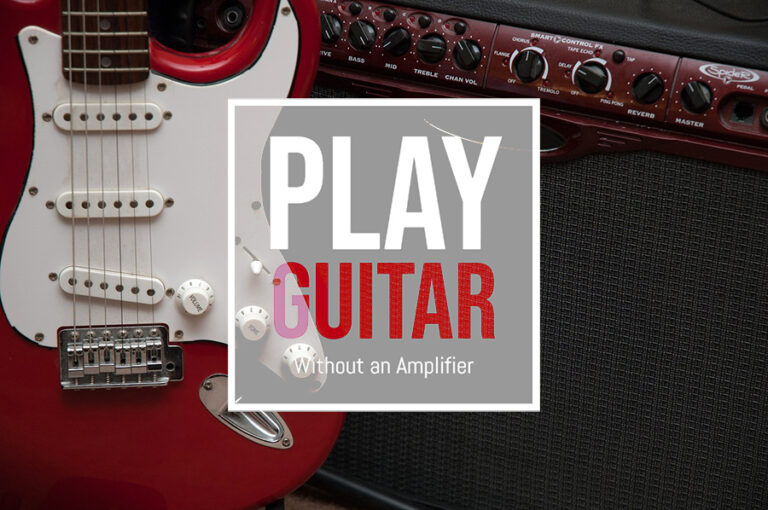Electric guitars owing to their very construction, require external amplification to produce the intended sound. This doesn’t mean that they do not make any sound while not connected to an amp. Even with the lack of a soundbox which is the hollow chamber in an acoustic guitar that physically amplifies the sound of the strings’ vibrations, electric guitars do produce sound when played unplugged, albeit very “thin” and soft and almost like an acoustic guitar.
And, of course, effects like distortion and reverb, which are almost always used to some extent with electric guitars, are impossible without an amp.
So, answering the question:
Yes, you can play the electric guitar without an amp if you do not mind the low volume and the lack of effects. However, there is an in-between method of using other low-cost and smaller devices along with things you already might have, like headphones, a PC, or a home theater system. And in some cases, you’ll get the sound output very close to, if not the same, as with a traditional guitar amp.
If you’re starting out with an electric guitar having to invest in a full setup would mean spending a lot of money upfront, which is not necessary thanks to technological advancements. It is possible to get the best out of your guitar with smaller and cheaper devices that connect to headphones or speakers you already own, making amps no longer necessary, especially for beginners.
Electric guitars do not come cheap, and for a beginner, especially, being able to practice and play without an amp would be a huge advantage from a monetary standpoint. Apart from that, there are a lot of times you wouldn’t want to use an amp, for example, if you’re a night person and wish to practice at night. Or, maybe your family or neighbors do not appreciate the sound much. Or, perhaps, you live in a small apartment and don’t want all your musical gears to take up the space they do.
Read on to learn more about how you can enjoy the maximum capabilities of your electric guitar and get the utmost enjoyment out of your practice without having to invest in an amplifier. But first, let’s examine how an electric guitar produces sound and why it needs an amp.
How Do Electric Guitars Produce Sound?
Electric guitars have a solid body fitted with electromagnetic pickups (usually two or more). When the guitar is played, the strings’ vibration produces (or induces) a tiny amount of electricity in the pickups, which then passes through the electrical circuit. This signal is then fed to the amp that amplifies it further, making it strong enough to drive a speaker and be audible for large performances or your bedroom.
The main takeaway here is that rather than picking up the sound of the vibrations produced from the strings, electric signals are produced by the movement of the strings by a process called induction. This subsequently means that electric guitars are designed to not make much sound without external amplification. When played without an amp, the volume would not be even close to an acoustic guitar but would still be audible, especially if you’re playing or practicing in your bedroom.
4 Ways to Play Guitar Without an Amp
Having learned the basics of how the electric guitar works along with the amp to produce the sound. Let’s now look at 4 ways you can play the electric guitar without an amp.
Also check: How to Power a Guitar Amp Outdoors
Using a Headphone Amplifier
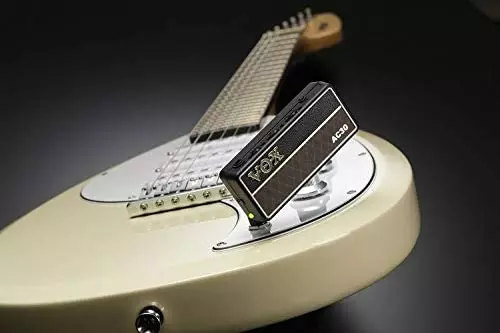
The headphone amp has to be one of the most valuable tools for a beginner guitar player. It is fast becoming a popular choice for practicing because of its portability, ease of use, and privacy they provide. These small battery-powered devices let you connect your guitar with your headphones, as guitars themselves do not have any amplification circuit.
There are varieties of headphone amps available in the market — a few with in-built speakers as well. Some of the more expensive ones also have EQ and effects settings that let you mimic the sound output of far more costly guitar amps without spending nearly as much.
The sound quality of headphone amps may not be as good as a full-fledged guitar amp, but they serve the purpose very well for guitarists.
To conclude, headphone amps are an excellent choice for portability and ease of use, along with being cheaper and allowing you to practice without disturbing anyone.
Multi-Effects Pedal
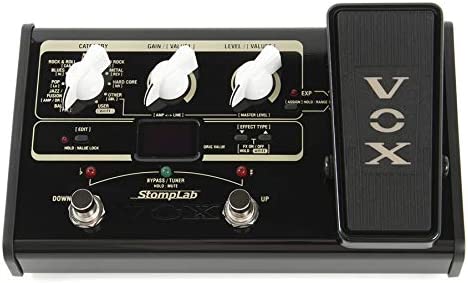
A multi-effects pedal is one of the most versatile devices that would greatly help you with your guitar practice and playing. These devices let you add effects like reverb, overdrive, distortions, etc., and give you the ability to connect to amps, headphones, or speaker systems you have. They also let you mimic the sound output signature of popular and expensive guitar amps.
Some of the models even support bass guitars along with regular electric guitars. This is a big advantage for those interested in both instruments as bass guitars, which require a different amp (a bass amp) to produce their intended sound.
While the higher-end models cost as much or more than an affordable guitar amp, the ability to plug into any speaker system like a studio monitor that produces excellent sound and to be able to imitate the tonal output of very high-end guitar amps is something that will attract a lot of guitarists. Some musicians swear by their multi-effects pedal and use it for their gigs and live performances.
Home Theater/Stereo System/Boombox
If playing loud is something you want without investing in an amp, this might be the way to go. You can connect your speaker system to your guitar, whether a home theater system or a boombox. You’ll need a 3.5mm to 6.35mm or (1/8th inch to 1/4th inch) connector. Use the adapter to plug your guitar into the speaker system’s line-in port, and you’re good!
Remember to start with the volume turned all the way to the lowest before switching on the system and gradually work your way up until you hear the guitar’s sound. Also, be careful not to go overboard with the volume. If you’re guitar (with active pickup) has EQ and volume knobs, do remember to start with a lower volume again and keep the EQ effects to the minimum you’re happy with.
Home speaker systems are not for guitar playing and will produce unsatisfactory output with a bass-heavy sound. You can tune this to a certain degree if your system has bass and treble controls but still, do not expect a sound that would even come close to a guitar amp.
As long as you have your expectations in check and do not go overboard, the speakers you have may be used as an alternative to the more expensive guitar amps with satisfactory results.
Computer/Laptop
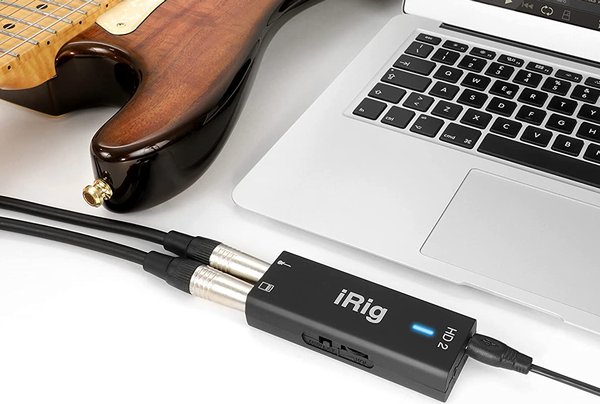
The most affordable yet versatile option if you’re looking for an amp that doesn’t cut corners as far as sound output and tonal quality are concerned. Whether you have a Windows PC or Mac, you can use an audio interface device that converts the guitar’s analog signal to digital signals and connects to your PC/Mac’s USB port. The next step is to use Digital Audio Workstation (DAW) software to process the signals from the USB port, which can then be played through your computer’s speakers or even recorded and edited.
You can use free software like Audacity (PC) or Garageband (Mac). The advantage of using a computer is that it provides you with virtually unlimited capabilities. With high-end paid DAW like BIAS FX, you get a lot of customizable settings for almost every effect under the sun.
This setup can produce a sound output rivaling the most expensive amps without buying additional hardware as long as you use great-quality speakers or headphones. Not to mention the ability to record every session.
With something like a $150 audio interface and software worth as much, you get a lot of versatility insofar as effects and overall tone output is concerned.
Smartphone/Tablet
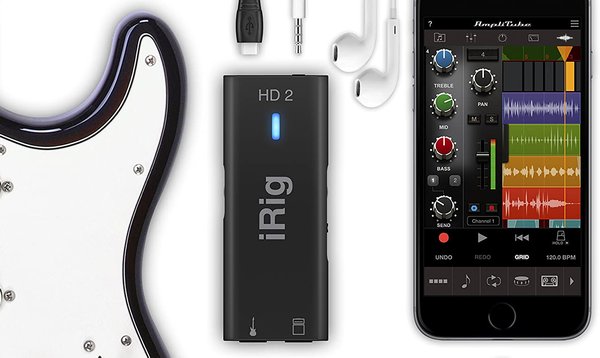
Similar to connecting the guitar with a computer, with technological advancement, today’s smartphones are more than capable of producing excellent sound. This gives you great convenience in terms of portability, ease of use, cost, and power in terms of effects that could rival standalone effect pedals.
You’ll need to buy an audio interface similar to connecting to a computer. Most of the audio interfaces available can connect to PCs and mobile devices, and some even come with their proprietary software. These devices also do not cost a lot. Because you can use them with such a wide array of devices, they are pretty much the most cost-efficient way of playing and recording guitar without buying an actual guitar amp.
A good quality audio interface (under $100) along with a professional app on the smartphone could actually be a replacement for a guitar amp if you have good quality speakers/headphones to go along with them. Even though the sound quality may not rival the PC, it would be on par with many effects pedals, and the portability is unmatched.
Other Methods to Play Guitar Without an Amp
Using a Semi-Acoustic Guitar
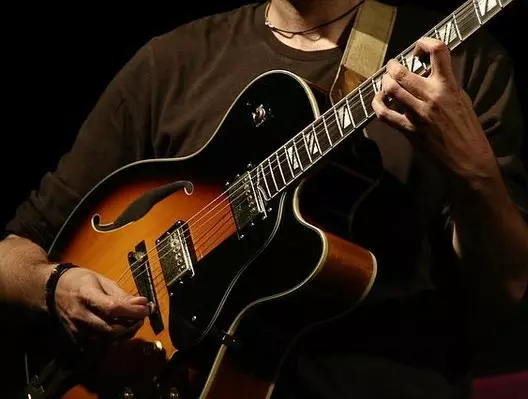
Semi-acoustic guitars are essentially electric guitars with semi or full-hollow bodies acting as the sound chamber (or soundbox), similar to acoustic guitars.
These guitars can be played unplugged for practice or intimate gigs in a small room and will produce enough volume. One thing to note, though, is that they have a different — sweeter, funkier sound signature, which is liked by musicians of specific genres such as funk, blues, etc.
Semi-acoustic guitars aren’t a straight-up replacement for electric guitars, but if you are more inclined to play unplugged a lot of times or like the tone these guitars produce, then semi-acoustic could be the right choice for you.
Other Questions on Guitar Amp Substitutes
Can You Connect an Electric Guitar to the Speakers That You Have?
Yes, you can. You can use a variety of methods:
- You can directly connect the guitar to the AUX port via an adapter.
- Using a headphone amp as some speakers, especially computer speakers and speakers intended to connect to your mobile phones, may not be able to amplify your guitar’s signal directly. In such a case, you can use a headphone amp.
- You can also use an effects pedal.
- You can also use your PC/Mac/Smartphone/Tablet to connect to your speakers and use the software to add effects. For this, you’ll need an audio interface, a relatively cheap device that acts as a bridge between your computer/mobile device and your guitar.
Can You Plug a Headphone Directly into My Guitar?
No, almost none of the guitars have a headphone jack. Besides the jack being of different sizes (guitar being 6.35mm or 1/4th inch and most headphones being 3.5mm or 1/8th inch), guitars do not produce an electric current strong enough to drive the headphone speakers. Even guitars with active pickups and a pre-amp on board would not be able to produce any sound without an actual amplifier like a small headphone amp.
Can You Play Bass Guitar Without a Bass Amp?
Yes, you can play the bass unplugged, but you’ll not hear much, which kind of defeats the purpose of the bass.
You can use a regular guitar amp, as discussed here.
Many of the alternatives discussed in this article would also work with bass guitars, and they would be a good choice for bass guitars if you have quality speakers. Studio monitors, for example, would produce good sound with an effect pedal or via software DAWs.
Can You Learn to Play Electric Guitar Without an Amp?
Yes, you can. You can even start with playing unplugged or trying one of the abovementioned alternatives.
How Loud Is an Electric Guitar Without an Amp?
It depends on what alternative method you use. Something like using a home theater would be as loud as the home theater itself. On the other hand, playing a guitar unplugged will produce minimal sound. Still, good enough for practicing in your bedroom.
Can You Play Electric Guitar Without Electricity?
You can play an electric guitar without electricity which is called playing unplugged, which produces very little sound but is still perfectly audible in practice settings like a small room without much external noise. Some guitars, like the hollow or semi-hollow body (discussed above), produce sufficient volume when unplugged, even for smaller, intimate gigs.
How Loud Is an Electric Guitar with Headphones?
Loud enough. In most cases, you wouldn’t be able to max out the volume as that would be too loud. Remember, regularly playing at high volumes through your headphone may damage your ears, so keep the volume at levels where it’s perfectly audible but not too loud.
Final Thoughts
There are a lot of ways to play an electric guitar without the need for an amp. Some methods will save you money, and some will give you privacy and not have to deal with a nagging neighbor. Many methods would produce sound on par with a standalone amp for far less money if you can settle for less volume.
So whether you’re a beginner starting with an electric guitar looking for a cheaper way to learn and practice or an intermediate guitarist who wants to practice without disturbing others, the guitar amp substitutes discussed can help you produce great sound on a budget.

